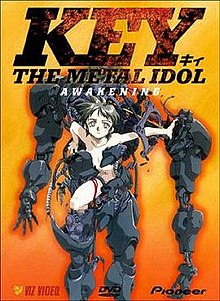1994 original video animation anime series directed by Hiroaki Sato From Wikipedia, the free encyclopedia
Key the Metal Idol (キィ・ザ・メタル・アイドル, Kii Za Metaru Aidoru) is a Japanese original video animation (OVA) series that was released from December 1994 to June 1997. The series consists of fifteen episodes divided into four parts. First Program consists of episodes 1 through 7. Second Program is 8 through 13. Third Program and Final Program are feature length (a.k.a. episodes 14 and 15) respectively. Key is a serious and somewhat dark drama with elements of mecha and science fiction.
| Key the Metal Idol | |
 The first volume of the American DVD release | |
| キィ・ザ・メタル・アイドル (Kii Za Metaru Aidoru) | |
|---|---|
| Original video animation | |
| Directed by | Hiroaki Satō[1] |
| Produced by | Shigehiro Suzuki Atsushi Tanuma |
| Written by | Hiroaki Satō |
| Music by | Tamiya Terashima |
| Studio | Pierrot |
| Licensed by | [2] |
| Released | December 16, 1994 – August 7, 1996 |
| Runtime | 25–30 minutes (each) |
| Episodes | 13 |
| Anime film series | |
| Directed by | Hiroaki Satō (Chief) Shigeru Ueda |
| Produced by | Ryunosuke Tsuno Eriko Aoki Utako Shirakawa |
| Written by | Hiroaki Satō |
| Music by | Tamiya Terashima |
| Studio | Pierrot |
| Licensed by | |
| Released | March 21, 1997 – June 18, 1997 |
| Runtime | 90 minutes (each) |
| Films | 2 |
The central character of the story is Tokiko Mima (nicknamed "Key"), who believes herself to be a robot crafted by her scientist grandfather, Murao Mima. Every year, on her birthday, Key believes Dr. Mima builds her a new body, each one size larger. Upon his deathbed, Mima records his will on audio tape, revealing that Key can become human with the aid of 30,000 friends. Key believes she must do this quickly before her battery runs down, and attempts to gain the amount of friends by becoming a Japanese idol. The series details the slow unraveling of Key's identity and a secret conspiracy bent on controlling her unique supernatural abilities she develops over the course of the narrative.
Key the Metal Idol, was originally produced and sold as an "experimental" title, with the original release media (VHS Tapes and LDs) priced very low, at 2,500 yen for a single-episode tape or 5,800 yen for a 3-episode LD, with the first episode retailing at 1000 yen. This was less than half the typical price of OVA titles at the time. As the series progressed, the episode lengths and volume costs continued to increase. The final volumes were priced 9,500 yen each, which was consistent with other titles at the time.
The series is also unusual in that the episodes are of varying length. The first thirteen episodes are approximately 25–30 minutes each. The final two episodes are 90 minutes each. In addition to the OVA series, Radio Drama CDs were made. The anime and soundtrack were released in the United States by Viz Video on eight VHS tapes and three DVDs in 1997–2000, and later all together as a box set in 2004.
The anime was re-licensed by Discotek Media and it was released on DVD on February 28, 2017.[2]
| No. | Title | Directed by | Original release date |
|---|---|---|---|
| 01 | "Startup" Transliteration: "Kidō" (Japanese: 起動) | Kazunori Mizuno | 16 December 1994 |
| 02 | "Cursor I" Transliteration: "Kāsoru I" (Japanese: カーソル I) | Masashi Abe | 17 February 1995 |
| 03 | "Cursor II" Transliteration: "Kāsoru II" (Japanese: カーソル II) | Nobuhiro Kondo | 1 March 1995 |
| 04 | "Access" Transliteration: "Akusesu" (Japanese: アクセス) | Akira Mano | 5 April 1995 |
| 05 | "Scroll I" Transliteration: "Sukurōru I" (Japanese: スクロール I) | Masashi Abe | 7 June 1995 |
| 06 | "Scroll II" Transliteration: "Sukurōru II" (Japanese: スクロール II) | Nobuhiro Kondo | 5 July 1995 |
| 07 | "Run" Transliteration: "Ran" (Japanese: ラン) | Yorifusa Yamaguchi | 2 August 1995 |
| 08 | "Go To" Transliteration: "Gōtū" (Japanese: ゴートゥー) | Kazunori Mizuno | 7 February 1996 |
| 09 | "Return" Transliteration: "Ritān" (Japanese: リターン) | Koji Masunari | 6 March 1996 |
| 10 | "Bug" Transliteration: "Bagu" (Japanese: バグ) | Yorifusa Yamaguchi | 3 April 1996 |
| 11 | "Save" Transliteration: "Sēbu" (Japanese: セーブ) | Takashi Watanabe | 2 May 1996 |
| 12 | "Virus I" Transliteration: "Vairasu I" (Japanese: ヴァイラス I) | Yorifusa Yamaguchi | 3 July 1996 |
| 13 | "Virus II" Transliteration: "Vairasu II" (Japanese: ヴァイラス II) | Kazunori Mizuno | 7 August 1996 |
| 14 (film 1) | "System" Transliteration: "Shisutemu" (Japanese: システム) | Shigeru Ueda | 21 March 1997 |
| 15 (film 2) | "Exit" Transliteration: "Shūryō" (Japanese: 終了) | Shigeru Ueda | 18 June 1997 |
Seamless Wikipedia browsing. On steroids.